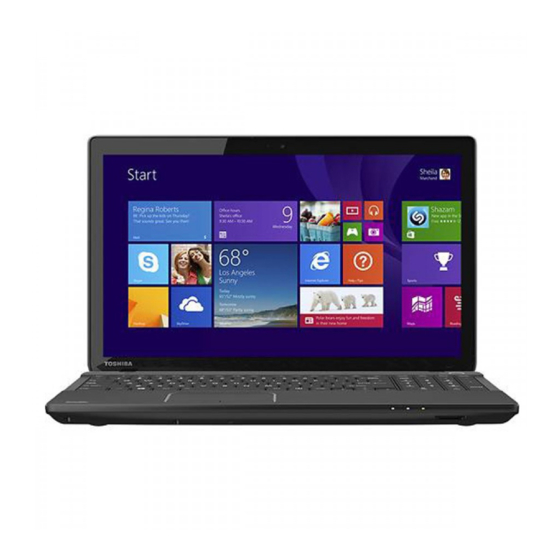Table of Contents
Advertisement
Satellite
C40/C50/C70
User's Guide
If you need assistance:
Technical support is available online at Toshiba's Web site at
support.toshiba.com. At this Web site, you will find answers for
many commonly asked technical questions plus many
downloadable software drivers, BIOS updates, and other
downloads.
For more information, see
page 125
®
/Satellite Pro
in this guide.
- A Series
"If Something Goes Wrong" on
®
GMAD00349010
04/13
Advertisement
Table of Contents

Summarization of Contents
Introduction
About This Guide
Provides an overview of the manual's content, structure, and how to effectively use its information.
Safety Icons and Information
Explains hazard symbols (Danger, Warning, Caution) and provides important safety cautions for user protection.
Computer Features and Documentation
Details system specifications and lists the documentation included with the computer.
Service and Support Options
Information on warranty, extended services, and contact points for technical assistance.
Chapter 1: Getting Started
Setting Up Your Workspace
Guidance on selecting a suitable location and arranging the work environment for optimal use.
Ergonomics and Comfort
Recommendations for maintaining proper posture, comfortable typing, and overall ergonomic usage.
Computer Setup and Initial Use
Steps for connecting power, charging the battery, and performing the first-time computer setup.
Basic Computer Operations
Instructions for properly shutting down, restarting, and using the computer's Sleep mode.
Hardware and Memory Installation
Procedures for adding external devices and installing or removing memory modules (RAM).
System Recovery and Refresh
Steps for creating recovery media, restoring, refreshing, and resetting the PC.
Peripheral Device Usage
How to use touch pads, external displays, and other connected peripherals.
Computer Care and Maintenance
Tips for cleaning, moving, and securing the computer to ensure longevity.
Chapter 2: Learning the Basics
Essential Computing Practices
Advice on saving work, backing up files, virus scanning, and general usage tips.
Keyboard and Input Devices
Using the keyboard, function keys, and special Windows keys for efficient operation.
Touch Screen and Mouse Operations
Navigating the interface using the touch screen and customizing mouse properties.
Application and File Management
Instructions on starting applications and managing files, including saving and backing up.
Optical Disc Drive Usage
Steps for inserting, playing, recording, and removing discs from the optical drive.
Chapter 3: Mobile Computing
Battery Management and Power Saving
Details on energy-saver design, battery monitoring, and power conservation techniques.
Battery Care and Disposal
Safety precautions, maintenance tips, and proper methods for battery disposal.
Traveling with Your Computer
Precautions and tips for using the computer effectively while traveling.
Chapter 4: Exploring Your Computer’s Features
Navigating Windows 8 Interface
Guidance on exploring the Start screen, Charms bar, and Desktop elements.
System Notifications and Store
Managing system notifications and accessing the Windows Store for applications.
Communications and Networking
Steps for setting up internet connectivity and connecting to networks.
Audio and Camera Features
Using microphones, speakers, headphones, and the built-in web camera.
Memory Card Reader Usage
Instructions for inserting and safely removing memory media like SD cards.
Chapter 5: Utilities
Desktop Assist Utility
Provides quick access to computer functions and allows customization of system settings.
eco Utility®
Monitors power savings from the eco power plan and tracks consumption.
Password Management
Setting and managing supervisor and user passwords for system security.
System Settings Configuration
Adjusting various system parameters, preferences, and hardware settings.
Function Key Operations
Using function keys to control system functions like touch pad status.
Recovery and Application Tools
Utilizing Recovery Media Creator and TOSHIBA Application Installer.
Chapter 6: If Something Goes Wrong
Basic Troubleshooting Steps
Resolving common program issues like applications not responding and startup problems.
Operating System and Internet Issues
Troubleshooting Windows OS failures, internet connectivity, and network problems.
Hardware and Peripheral Troubleshooting
Diagnosing issues with devices, memory, power, keyboard, display, storage, optical drives, sound, and printers.
System Restore and Backup
Saving system configuration, backing up data, and using restore points for recovery.
Seeking Further Assistance
Guidance on where to find additional technical support and resources.
Appendix A: TOSHIBA Function Keys
Function Key Operations Guide
Overview of how function keys modify system functions and launch applications.
Specific Function Key Controls
Details on Function keys for help, display brightness, output switch, touch pad, media, volume, wireless, keyboard, and zoom.
Glossary
Technical Acronyms
A list of common abbreviations used throughout the user's guide.
Glossary of Terms
Definitions of key technical terms related to computer hardware, software, and operations.
















Need help?
Do you have a question about the C55T-A5102 and is the answer not in the manual?
Questions and answers